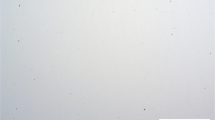Abstract
The injection molding of micro-structures is a promising mass-production method for a broad range of materials. However, the replication quality of these structures depends significantly on the heat flow during the filling stage. In this paper, the filling and heat transfer of v-groove and random structures below 5 μm is investigated with the help of an AFM (atomic force microscope) and thermo couples. A numerical model is developed to predict the filling of surface structures during the filling and packing stage. The model implies the use of simple fully developed flow models taking the power-law material model into account. This permits investigation into which ways several processing parameters affect the polymer flow in the surface structures. The mold wall temperature, which has significant effects on the polymer flow, is varied by using a variothermal mold temperature control system to validate the model proposed.















Similar content being viewed by others
References
Attia UM, Alcock R (2009) Integration of functionality into polymer-based microfluidic devices produced by high-volume micro-moulding techniques. Int J Adv Manuf Technol. doi:10.1007/s00170-009-2345-8
Attia UM, Marson S, Alcock JR (2009) Micro-injection moulding of polymer microfluidic devices. Microfluid Nanofluidics 7:1–28. doi:10.1007/s10404-009-0421-x
Baehr HD, Stephan K (2006) Heat and mass transfer. Springer, Berlin
Bendada A, Derdouri A, Lamontagne M, Simard Y (2004) Analysis of thermal contact resistance between polymer and mold in injection molding. Appl Therm Eng 24:2029–2040. doi:10.1016/j.applthermaleng.2003.12.027
Bigerelle M, Gorp AV, Iost A (2008) Multiscale roughness analysis in injection-molding process. Polym Eng Sci 48:1725–1736. doi:10.1002/pen
Bürkle E, Burr A, Müller M, Kübler M (2007) In three-seconds from 100 to 140 degree. Kunstst Int 10:144–148
Burmeister F, Kohn C, Kuebler R, Kleer G, Bläsi B, Gombert A (2005) Applications for TiAlN- and TiO2-coatings with nanoscale surface topographies. Surf Coat Technol 200(5–6):1555–1559. doi:10.1016/j.surfcoat.2005.08.062
Delaunay D, Le Bot P, Fulchiron R, Luye JF, Regnier G (2000) Nature of contact between polymer and mold in injection molding. Part I: influence of a non-perfect thermal contact. Polym Eng Sci 40(7):1682–1691
Despa MS, Kelly KW, Collier JR (1999) Injection molding of polymeric LIGA HARMs. Microsyst Technol 6:60–66
Giboz J, Copponnex T, Mélé P (2007) Microinjection molding of thermoplastic polymers: a review. J Micromech Microeng 17:R96–R109. doi:10.1088/0960-1317/17/6/R02
Huang CK (2007) Polymeric nanofeatures of 100 nm using injection moulding for replication. J Micromech Microeng 17:1518–1526. doi:10.1088/0960-1317/17/8/014
Kim D, Kim J, Park HC, Lee KH, Hwang W (2008) A superhydrophobic dual-scale engineered lotus leaf. J Micromech Microeng 18:015019 (5 pp). doi:10.1088/0960-1317/18/1/015019
Lalanne L, Hutley M (2003) Artificial media optical properties-subwavelength scale. Encycl Opt Eng. doi:10.1081/E-EOE-120009537
Lee SM, Lee HS, Kim DS, Kwon TH (2006) Fabrication of hydrophobic films replicated from plant leaves in nature. Surf Coat Technol 201:553–559. doi:10.1016/j.surfcoat.2005.12.006
Lee Y, Park SH, Kim KB, Lee JK (2007) Fabrication of hierarchical structures on a polymer surface to mimic natural superhydrophobic surfaces. Adv Mater 19:2330–2335. doi:10.1002/adma.200700820
Massé H, Arquis É, Delaunay D, Quilliet S, Le Bot PH (2003) Heat transfer with mechanically driven thermal contact resistance at the polymer–mold interface in injection molding of polymers. Int J Heat Mass Transf 47:2015–2027. doi:10.1016/j.ijheatmasstransfer.2002.04.001
Mönkkönen K, Hietala J, Pääkkönen P, Pääkkönen EJ, Kaikuranta T, Pakkanen TT, Jääskeläinen T (2002) Replication of sub-micron features using amorphous thermoplastics. Polym Eng Sci 42:1600–1608
Mosaddegh P, Angstadt DC (2008) Micron and sub-micron feature replication of amorphous polymers at elevated mold temperature without externally applied pressure. J Micromech Microeng. doi:10.1088/0960-1317/18/3/035036
Nosonovsky M, Bhushan B (2008) Biologically inspired surfaces: broadening the scope of roughness. Adv Funct Mater 18:843–855. doi:10.1002/adfm.200701195
Osswald T, Hernández-Ortiz JP (2006) Polymer processing—modeling and simulation. Carl Hanser Verlag, Munich
Pantani R, Santis FD, Brucato V, Titomanlio G (2004) Analysis of gate freeze-off time in injection molding. Polym Eng Sci 44(1):1–17
Pranov H, Rasmussen HK, Larsen NB, Gadegaard N (2006) On the injection molding of nanostructured polymer surfaces. Polym Eng Sci. doi:10.1002/pen.20459
Raguin DH, Morris GM (1993) Analysis of antireflection-structured surfaces with continuous one-dimensional surface profiles. Appl Opt 32(14):2582–2598. doi:10.1364/AO.32.002582
Squires TM, Quake SR (2005) Microfluidics: fluid physics at the nanoliter scale. Rev Mod Phys 77(3):977–1026
Xu G, Yu L, Lee LJ, Koelling KW (2005) Experimental and numerical studies of injection molding with microfeatures. Polym Eng Sci. doi:10.1002/pen.20341
Yao D, Kim B (2002) Simulation of the filling process in microchannels for polymeric materials. J Micromech Microeng 12:604–610. PII:S0960-1317(02)33062-6
Yoo YE, Kim TH, Choi DS, Hyun SM, Lee KH, Kim SK, Kim BH, Seo YH, Lee HG, Lee JS (2009) Injection molding of a nanostructured plate and measurement of its surface properties. Curr Appl Phys 9:e12–e18. doi:10.1016/j.cap.2008.12.023
Yoshii M, Kuramoto H, Ochiai Y (1998) Experimental study of the transcription of minute width grooves by injection molding. Polym Eng Sci 38(9):1587–1593
Young WB (2005) Simulation of the filling process in molding components with micro channels. Microsyst Technol 11:410–415. doi:10.1007/s00542-004-0474-4
Yu L, Lee LJ, Koelling KW (2004) Flow and heat transfer simulation of injection molding with microstructures. Polym Eng Sci 44(10):1866–1876. doi:10.1002/pen.20188
Author information
Authors and Affiliations
Corresponding author
Rights and permissions
About this article
Cite this article
Kuhn, S., Burr, A., Kübler, M. et al. Study on the replication quality of micro-structures in the injection molding process with dynamical tool tempering systems. Microsyst Technol 16, 1787–1801 (2010). https://doi.org/10.1007/s00542-010-1104-y
Received:
Accepted:
Published:
Issue Date:
DOI: https://doi.org/10.1007/s00542-010-1104-y



